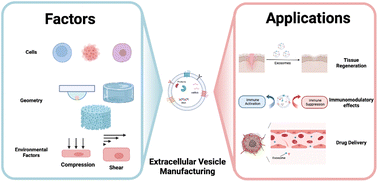Biomaterial-enabled 3D cell culture technologies for extracellular vesicle manufacturing
Abstract
Extracellular vesicles (EVs) are lipid-based particles naturally released from cells and recognized as promising drug delivery vehicles for improving therapeutic outcomes. Efficient manufacturing of therapeutic EVs have been challenging for their clinical translations. Three-dimensional (3D) cell cultures enabled by biomaterial scaffolds have been used as a platform for improving EV manufacturing compared to conventional methods such as isolation from bodily fluids and standard Petri-dish cell culture. Recent studies on 3D culture derived EV production prove it to enhance the EV yield, functional cargos, and therapeutic efficacies. However, there are still challenges with scaling up 3D cell culture production platforms for industrial use. Hence, there is a high demand for designing, optimizing, and implementing large scale EV manufacturing platforms derived from 3D cell cultures. We will first review the current advances of biomaterial-enabled 3D cell cultures in EV manufacturing, followed by the effect of these 3D cell culture platforms on the EV yield, the EV quality, and therapeutic efficacies. Lastly, we will discuss the key challenges and potential for implementing biomaterial-enabled 3D culture in EV manufacturing for large scale processes in the industrial use.



 Please wait while we load your content...
Please wait while we load your content...